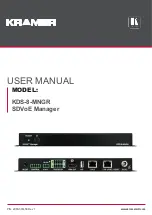
RASFinder RF300E/RF310E User Guide
RF300E/RF310E
136
Command: Z
Function:
Reset to Stored Profile
Unit:
n/a
Values:
n/a
Default:
n/a
Description:
The Z command resets the TA to its current power-up profile and clears the
command buffer. The result is the same as turning the TA off and on. When you type
ATZ<CR>, the state of the &W command determines where the default values
originate. &W0 defaults come from the customized configuration in NVRAM, and
&W1 defaults come from the factory default configuration in ROM. Because Z clears
the command buffer, it must be the last command in a command string; normally it is
issued by itself: ATZ<CR>. Note that whereas the &F0 reset command always
restores the factory default profile, the Z reset command restores either the factory
default or the stored profile, depending on how the &W command is set.
Command: &Zn=x
Function:
Store Telephone Number
Unit:
Decimal ASCII code
Values:
n=0-9; x=dial string
Default:
n/a
Description:
The &Zn=x command lets you store a telephone number in a memory register for
faster dialing. To store a number, type &Z, the register number (0-9) where you want
to store the number, the = character, and the dialing string that you want stored; then
press <CR>. The dialing string can have up to 25 characters. To read a specific
stored number, type AT&Zn? (e.g., AT&Z4?) where n is the number of the register
you want to read. To display the list of all numbers stored in memory, type ATL<CR>.
Command: !Z=n
Function:
Rate Adaption/Data Protocol
Unit:
Decimal ASCII code
Values:
n=5—V.120 (async, error detection, error correction)
n=7—HDLC (async, error detection)
n=9—PPP (async, error detection)
n=12—X.75 (async, error detection, error correction)
Default:
!Z=9 (PPP)
Description:
The !Z=n command selects the rate adaption protocol used to communicate with
another TA. The local and remote TAs must be set to the same protocol for
communication to take place, unless the remote TA supports automatic protocol
detection. See S52 for a description of automatic protocol detection supported by this
TA. Some protocols support error correction, such as V.120 and X.75. Other
protocols, such as PPP, rely on the upper layers (the computer) to handle error
correction. The TA will allow reception of V.110 calls which will be routed directly to
the modems. See the description for S-register S83 for further information regarding
routing of V.110 calls.
Summary of Contents for RASFinder RF300E
Page 5: ...Remote Access Device Chapter 1 Introduction and Description ...
Page 11: ...Remote Access Device Chapter 2 Installation ...
Page 14: ...RASFinder RF300E RF310E User Guide RF300E RF310E 14 ...
Page 15: ...Remote Access Device Chapter 3 Software Loading and Configuration ...
Page 35: ...Remote Access Device Chapter 4 RASFinder Software ...
Page 72: ...RASFinder RF300E RF310E User Guide RF300E RF310E 72 ...
Page 73: ...Remote Access Device Chapter 5 Client Setup ...
Page 90: ...RASFinder RF300E RF310E User Guide RF300E RF310E 90 ...
Page 91: ...Remote Access Device Chapter 6 RAS Dial Out Redirector ...
Page 99: ...Remote Access Device Chapter 7 Remote Configuration and Management ...
Page 108: ...RASFinder RF300E RF310E User Guide RF300E RF310E 108 ...
Page 109: ...Remote Access Device Chapter 8 Service Warranty and Tech Support ...
Page 113: ...Remote Access Device Appendixes ...
















































